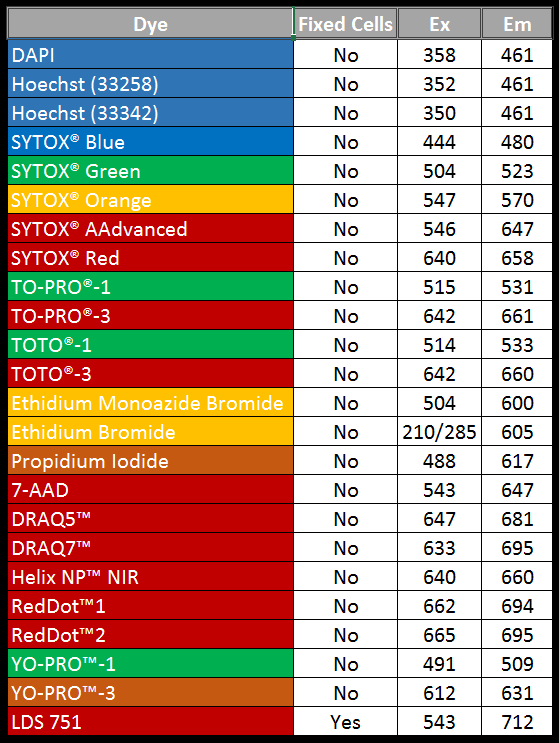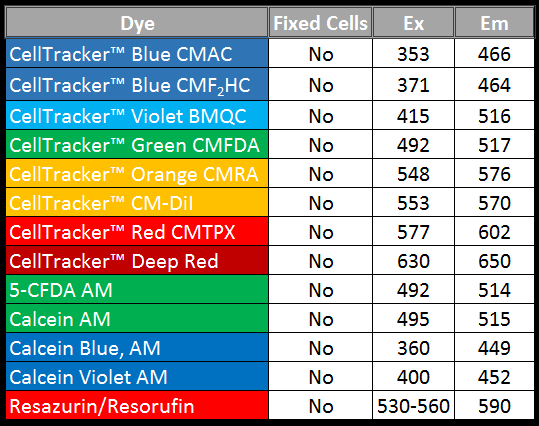Cell viability dyes are critical controls for proper flow cytometry analysis. Dead cells can skew data by causing cell aggregation, contributing to cellular autofluorescence or nonspecifically binding detection antibodies. This is especially problematic when measuring low-expression antigens or counting rare cell populations.
It is therefore important to identify dead cell populations with a viability dye, and exclude them from your results by proper gating. This guide with help explain the various types of viability dyes, explore their respective benefits, and summarize the commercially available dyes for each group.
Sections:
DNA Binding Dyes
Tried and true, DNA dyes are inexpensive and easy to use. These dyes are incapable of passing through the intact membranes of living cells (impermeant), and will therefore only bind DNA of dead cells. Unfortunately, they are not typically useful for fixation and permeabilization experiments.
 Cell colors are approximations and observed colors may vary.
Cell colors are approximations and observed colors may vary.
*SYTOX®, TO-PRO®, TOTO®, and YO-PRO™ are registered trademarks of Thermo Fisher Scientific. DRAQ® is a registered trademark of Biostatus Limited. Helix NP is a trademark of Biolegend. RedDot™ is a trademark of Biotium.
Amine Reactive Dyes
Amine dyes react with the amine groups of cellular proteins. Impermeant to intact cell membranes, these dyes will only react with a few proteins on the surface of living cells. Whereas they can react with many more proteins inside of dead cells, resulting in higher fluorescence.
Amine dyes can be used for fixation and permeabilization protocols, and can easily be paired with amine-reactive beads as a compensation control. However, amine dyes will likely add significant time to your fixation protocol. Additionally, they will react with any free protein contained in your sample.
 *Zombie™ is a trademark of Biolegend. eFluor™ and LIVE/DEAD™ are trademarks of ThermoFisher Scientific. Viobility™ is a trademark of Miltenyi Biotec. Horizon™ is a trademark of BD Biosciences. Ghost Dye™ is a trademark of Tonbo Biosciences. Live-or-Dye™ is a trademark of Biotium. VivaFix™ is a trademark of Bio-Rad Laboratories.
*Zombie™ is a trademark of Biolegend. eFluor™ and LIVE/DEAD™ are trademarks of ThermoFisher Scientific. Viobility™ is a trademark of Miltenyi Biotec. Horizon™ is a trademark of BD Biosciences. Ghost Dye™ is a trademark of Tonbo Biosciences. Live-or-Dye™ is a trademark of Biotium. VivaFix™ is a trademark of Bio-Rad Laboratories.
Enzyme Activated Dyes
Enzyme activated dyes can be applied to stain living cells without killing them. These dyes are often weakly or non-fluorescent until activated by an enzyme reaction. They freely pass through living cell membranes, where they are converted into membrane-impermeant, fluorescent reaction products. The dyes are retained in living cells through several generations, and can be transferred to daughter cells, making them useful for tracking cell movement and proliferation as well.
However, because these dyes require activation by active enzymes, they are not typically appropriated for fixation and permeabilization experiments.

*CellTracker™ is a trademark of Thermo Fisher Scientific.
Using a viability dye to identify and exclude dead cells will allow for cleaner separation, identification and analysis of cell your target cell populations. FluoroFinder supports incorporating all types of viability dyes during the experiment design process, so be sure to include one in your next experiment!





